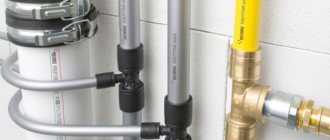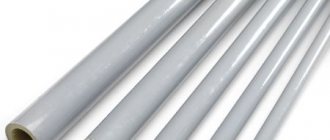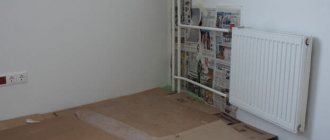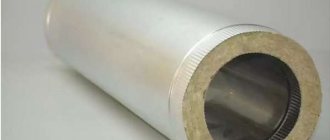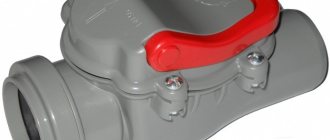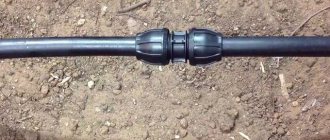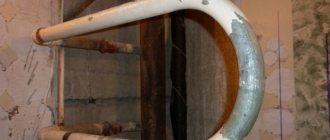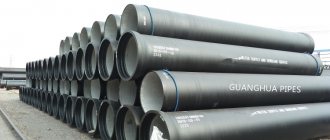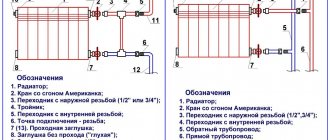Question: “How to soundproof sewer pipes in an apartment?” has become relevant with the widespread use of plastic sewage systems. If the cast iron pipes made noise, it was only a little and completely new, and soon after installation they became silent even on the first floors. Plastic for sewerage is superior to cast iron in everything except one thing - plastic pipes turned out to be very loud, which, by the way, came as a surprise even to experts. It is now believed that sound insulation of sewer pipes is absolutely necessary and should be provided for at the design stage of the sewer system. Fortunately, this activity is simple, inexpensive and does not require special skills or tools. Soundproofing sewer pipes with your own hands is possible for anyone who knows how to use scissors.
But the simplicity and ease of sewer soundproofing work is complicated by the variety of acoustic processes in the pipe and their interaction with the building structure. Simple “prescription” methods sometimes turn out to be ineffective for no apparent reason, and often invisible and inaudible, but dangerous and insidious acoustic effects are not neutralized. Therefore, noise insulation of the drain pipe must be carried out with full knowledge of the matter.
Why does plastic make noise?
Researchers find several sources of noise in the pipe:
- Impact - when the contents fall in the riser, they hit the walls.
- Atmospheric - simply the noise of the wind in a ventilated riser.
- Resonant – extraneous sounds are heard in the pipe.
- Vibration – vibrations of the building are transmitted to the pipe, etc.
Why is the trumpet so sensitive to sounds? Because it is a pipe, an acoustic resonance system, and, unlike an organ or wind pipe, it is multi-frequency. The length of sewer risers from bottom to top is from several meters to tens of meters; speed of sound in air – 330 m/s. The main resonant frequency of the riser will be from several hertz to tens of hertz, and the overtones will be located on the sound frequency scale at intervals equal to the fundamental frequency. That is, with the slightest periodic impact on the pipe, it will give an almost continuous hum: in the region of best audibility, the untrained human ear can no longer distinguish a frequency difference of 20 Hz.
Resonance phenomena in a pipe cause not only vibration of its walls, but also alternating deformations (bending, tension/compression) of the pipe body, i.e. pipes in general. The sound from the vibration of the walls is transmitted directly to the rooms, and alternating deformations, in addition, affect the structure of the building.
Sewer riser
Many people are interested in how to soundproof a sewer riser. This is where the most noise comes from.
And the noise it creates in the apartment is conventionally divided into:
- shock. It is created from the interaction of the fluid flow with the walls of the pipes. It is not at all possible to get rid of it, but it is quite possible to reduce it.
- Air. This is the sound from the air through which the flow of water passes.
- Structural. Appears after vibration of pipe materials and network elements that come into contact with each other.
It is the third type that we have to fight, as it creates the most serious problem.
To make sound insulation with your own hands you need:
- prepare the material and cut out a piece from it that will correspond to the dimensions of the riser circumference.
- Secure this part with construction tape. It is important that the edges are positioned end to end. Placing them in any other way will reduce efficiency.
- It is recommended to fasten soundproofing coverings for sewerage tightly, using the addition of several layers. This increases the weight of the structure and reduces resonance. As a result of these actions, structural sounds become less noticeable.
- If the need arises, a decorative box can be constructed around the sewer riser. This also has a positive effect on sound insulation in this situation.
Why doesn't cast iron make noise?
Why doesn't cast iron make noise? Metal is not noisy, but plastic is noisy? Metal, but not quite. Cast iron is a eutectic alloy, a collection of microscopic grains of different composition and properties. Because of this, cast iron has a low mechanical quality factor: the grains rub against each other, absorbing vibration. And the cast iron pipe quickly becomes overgrown with plaque inside, which additionally dampens vibrations.
Due to the eutectic structure, the elasticity of cast iron is also negligible - everyone knows how fragile it is. Before a cast iron product dings for any reason, it will fall apart. The frames of grand pianos and pianos are still cast from cast iron, ignoring the most modern materials: any other frame will either not withstand a string tension of 20 tons, or will produce overtones.
Soundproofing of pipes
Available soundproofing methods
It is possible to implement sound insulation of sewer pipes using the following methods:
- The use of special “silent” pipes.
The most modern sound-absorbing sewer pipes made of mineralized high-density polypropylene produced by some manufacturers have already proven themselves to be the quietest pipes. The multilayer thick walls of these pipes perfectly absorb sound. Their only (so far) drawback is their high cost.
Reducing noise with silent pipes
- Use of soundproofing material.
The special material used to wrap existing pipes also has the necessary thermal insulation properties. Such soundproofing of plastic sewerage costs much less than special pipes. But its installation requires an incomparably large amount of labor and time.
Types of soundproofing material
Soundproofing of sewer pipes can be done by tightly wrapping them along their entire length with various materials:
- Foamed polyethylene. An excellent sound-absorbing material and at the same time a good heat insulator, foamed polyethylene also prevents the formation of condensation on the pipes, thereby protecting them from the possible formation of mold and fungi.
Pro tip: Choose a material that has a tougher outer film layer to ensure the coating you use lasts as long as possible.
- Soundproofing tape. A special soundproofing tape is wrapped in several layers with maximum density around the pipe.
Pro tip: Pay attention to the specification of the insulating material, which indicates the number of decibels it can absorb. The soundproofing effect depends on this value.
- Roll insulation. Not new, but well-proven and still used material is used as an alternative to more modern types of insulation.
Roll insulation winding diagram
Pro Tip: Try not to allow air bubbles between layers of insulation.
About infrasounds
Infrasounds are sound vibrations with a frequency below 20 Hz, inaudible to the ear. Strong and/or prolonged infrasound is extremely harmful and dangerous: 7 Hz leads to epilepsy and drives you crazy, 0.5-2 Hz causes causeless hysteria and can stop the heart. Other infrasounds do not act as directed, but are no more useful.
During the war, the Germans tried to create a vortex anti-aircraft gun using infrasound, which would kill pilots. In the 50s and 60s in the USA, USSR and France, the military conducted top-secret experiments on the combat use of high-intensity infrasounds. The sources were the most compact of infrasound emitters - Levavasseur vortex whistles.
The results exceeded all expectations: 1.5 km from the emitter, the experimental subjects died where they stood, or instantly went crazy. The birth of a new monstrous weapon was prevented by circumstances that cannot be circumvented by the tricks of high technology: the dimensions of the emitter must be comparable to the length of the sound wave. The "compact" vortex whistle was 8.2 m in diameter and 2 m in height, and required a battery of whistles to create directional radiation. And in any case, infrasound diverges widely and penetrates tens of meters deep into the earth, so it is impossible to protect one’s own from it.
More than 20 years ago, a group of WHO (World Health Organization) experts came to the conclusion that an important factor causing the “debility” of modern civilization is the increased level of infrasound in megacities and industrial zones.
But what does sewerage have to do with it? In addition to acoustic resonance, a sewer pipe can also experience mechanical resonance, the resonance of the pipe body itself. And its frequencies are infrasonic. The pipe itself is not capable of emitting infrasound: its diameter is hundreds and thousands of times smaller than the length of infrasound waves, and an acoustic short circuit occurs - before it has time to move away from the pipe, the infrasound destroys itself.
However, the building, in terms of its size, configuration and mechanical quality, is a suitable infrasonic resonator, and vibrations of the pipe body can be transmitted to its structure through the floors through which it passes and the walls to which it is rigidly attached.
Noise Elimination Methods
If it turns out that the sewerage system runs in the living room, then the most correct solution would be not to soundproof the pipes, but to relocate them. Such a solution to the problem can be carried out exclusively at the construction stage. It will no longer be possible to move after the work is completed. The funny thing is that this situation also occurs in new buildings due to miscalculations in the design. In practice, the drain pipe most often runs in the bathroom or toilet, if the bathroom. the node is not combined. Now directly about the methods.
Soundproofing a toilet in a private low-rise building or in an apartment as a whole can be done through the following operations.
- Installation of silent pipes.
- Fastening soundproofing materials.
- Installation of rigid clamps in order to make the sewerage structure more static.
- Box installation.
- Installation or repair of a drain pipe.
Photo: sewer pipe secured with a clamp
Silent pipes
Silent pipes can be called a novelty on the building materials market. They are not yet used so often, but are successfully gaining recognition among buyers. Distinctive features of such a riser are a thickened wall and special components that are designed to prevent the penetration of sound and vibration into the room. It is noteworthy that silent pipes dampen even infrasound.
In addition to such positive qualities of the new material, there are a couple of significant drawbacks. The prices for such pipes are significantly higher compared to the classic PVC version. They also do not have a long service life, no more than 30 years. Of course, you can find more durable options, but the price will also increase progressively.
Fan pipes
At its core, this is ventilation for sewerage. In a private house, the height of which does not exceed two floors, the installation of vent pipes is not carried out, and there is actually no need for this. The legislation also does not impose requirements for this. For multi-storey buildings, the presence of a drain pipe is mandatory. It allows not only to equalize the pressure in the riser, but also through it the accumulated gases are released into the atmosphere, which can cause airborne noise.
A function similar to vent pipes, but indoors, can be performed by air valves. Their purpose is to let air into the sewer and at the same time prevent reverse movement. You can make noise insulation for air ducts using soundproofing materials, but so as not to block the flow. If the flow capacity is disrupted, water from the riser can be directed through the inlet channel.
Soundproofing
In practice, the most common situation is when the sewerage system has already been installed and its replacement will lead to unnecessary financial and labor costs. Thus, apartment residents who need to reduce the noise level from the riser resort to using various types of soundproofing materials. There are many options that can be used as such.
Soundproofing a sewer riser does not require any special skills; it is enough to have at least a little experience in installation work. The easiest way to do this is by using polyethylene foam or polyurethane foam.
As for the places where the riser passes through the floors of the building, as mentioned earlier, you should not use polyurethane foam, since it only increases structural noise. Instead, you should take porous rubber. This will minimize the likelihood of vibration transmission to the building structure and eliminate the acoustic effect.
On a note. The appearance of a sewer riser in soundproofing is not quite presentable. Based on this, it makes sense to cover the pipe with a decorative box. The design itself can be modified with various finishing materials.
Photo: Sewer pipes in a box
The box will not only create a more attractive appearance, but will also provide additional sound insulation. It is important to take into account the fact that it should not be made deaf. Access to the water supply is necessary, as it often runs in close proximity to the sewer pipe. There is a chance that you won’t have to do anything else behind the box, but the likelihood of an emergency should be taken into account. It is then that ease of access and efficiency of work can significantly reduce the harmful consequences of an unforeseen situation.
Materials
Among the materials that give the maximum effect can be used:
- Foamed polyethylene.
Photo: foamed polyethylene
- Polyurethane foam.
- Foam rubber.
Photo: foam rubber
- Foam shell.
- Mineral wool.
Important. It would be better to refrain from the last option, namely mineral wool. Naturally, it will fulfill its role, but it is quite unsafe for the health of household members.
Photo: mineral wool
Purpose of sewer soundproofing
From the above, an important conclusion for practice follows: the sound from the pipe in the apartment is structural; it is transmitted to the living room due to vibrations of the walls and body of the pipe. Therefore, sound insulation of sewer pipes should be limited to:
- Dampen vibrations of the pipe walls.
- Eliminate the transfer of alternating elastic vibrations of the pipe as a whole to the building structure.
The second important conclusion: the noise insulation of the riser should be of primary importance: it is the riser that transmits the most harmful, infrasonic vibrations to building structures.
Causes of noise
The main reason why the riser makes noise is the movement of water bodies. In addition, a noticeable hum is produced by excessive ventilation of the vent pipe in a private house. However, these reasons are far from the only ones. The riser may be noisy due to:
- conversations or other sounds coming through a hollow pipe from apartments above or below;
- knocking or rubbing against the walls of a loose pipe;
- resonance , at which the riser begins to hum strongly at a certain frequency.
Resonating of pipelines is dangerous because it causes mechanical deformations of the pipes, loosens the fastenings, and loosens the connections of individual sections. In addition, resonance phenomena can manifest themselves in the form of infrasonic vibrations, which are extremely dangerous to human health. Vibrations of the body of the sewer riser themselves occur at infrasonic frequencies, which should be known and taken into account when installing or arranging the system.
sound insulation
Factors such as:
- pipe wall thickness;
- riser material;
- method of fixing the pipeline.
Often there are several sources of noise at once, which forces you to look for a way to solve the problem. If the cause of extraneous sounds is excessive ventilation of the fan pipeline or the entire system, the right solution would be to contact specialists from the management company. It will require serious intervention in the design of the system, which cannot be done with your own hands.
If the sounds are of a different nature and arise due to mechanical reasons, the only option remains is to soundproof the sewer pipes in the apartment.
To what extent should I isolate?
Soundproofing costs money. And costs increase squarely depending on its efficiency, on how much it absorbs sound. In order not to sacrifice health with comfort, and not to spend too much, you need to know how much sound vibrations need to be damped.
The intensity of an audible sound when measuring its psychophysiological effect is correlated with the intensity at a frequency of 1000 Hz, i.e. uniform loudness is measured. The intensity of sound is measured in logarithmic units - bels, named after the inventor of the telephone and the pioneer of electroacoustics, Alexander Bell. In practice, a more convenient tenth of a white is used - decibel (dB). For sound at 1 kHz, the intensity values from various sources are as follows:
- The hearing threshold is 0 dB (10 to minus 12 degrees W/sq.m).
- Whisper or quiet day far outside the city - 20-30 dB.
- Apartment in an old building in a quiet area – 50-60 dB.
- Highway with heavy traffic, metalworking shop - 70-80 dB.
- Rock concert, forging and pressing shop – 90-100 dB.
- A jet plane taking off – 110-120 dB.
- Pain threshold – 130 dB (10 W/sq.m).
- Traumatic threshold (eardrums burst, blood flows from the ears) – 140 dB.
- The destruction threshold (shock wave of a nuclear explosion, lightning strike 10 m from the object) is more than 160 dB.
It follows that sound insulation of apartment sewerage should reduce sound by 20-30 dB. The standard value for the degree of sound insulation in residential premises is considered to be 26 dB (20 times), acceptable - 20 dB (10 times); high – 40 dB (100 times).
Do-it-yourself noise insulation of sewer pipes
Modern houses are surrounded by communications from the roof to the basement. All of them are designed to improve people's lives, make it more comfortable and easier, but sometimes it happens that they bring inconvenience. One of these inconveniences is caused by a plastic sewer drain, which, for all its practicality, creates more noise in the house than a cast iron one. This problem is especially acute for residents of apartment buildings who live on the lower floors. But this is not a reason to refuse this material and not use it. Soundproofing pipes with your own hands is quick and easy.
Table of contents:
Sources of noise in sewer pipes
The main culprit of sewer noise is the riser. Water flows in it can create very strong vibrations, which not only cause discomfort, but are also very harmful to physical and mental health, since there are decibel standards acceptable in a residential area.
The volume of sewerage sounds directly depends on the height of the building. The lower the apartment is, the greater the noise in the riser. It is quite simple to explain - as wastewater flows down, it collides with the pipe, various elements of the system and with each other. Vibrations are generated that are transmitted to the floors. Also, water flows collide with air inside the riser. The higher the speed of flowing water, the greater the air resistance. And this speed is higher, the longer the distance the runoff has already covered. Therefore, residents of apartments located closer to the basement feel much more discomfort from sewer noise than residents of upper floors.
Several types of noise are generated in the sewer riser:
- From the blow. It occurs when water comes into contact with sewerage elements when falling. This type of noise cannot be completely eliminated, but it can be easily minimized.
- Air. Its cause is the air contained in the riser. It is not as significant as the type of noise described above, and is rarely very noticeable against the general background.
- Structural. The most unpleasant type of noise that causes the most harm and discomfort. Its source is the inner surface of pipes, sewer parts, concrete floors and walls that come into contact with the sewer riser. During its passage through the pipe, water transmits vibration to them, which then spreads through all the mentioned elements and creates unpleasant sound effects. This type of noise must be eliminated first and is the easiest way to do it.
Methods of noise insulation of sewerage
Structural absorption
The best sound insulation of plastic sewer pipes is carried out in the pipe itself. These are noise-absorbing pipes: mineral powder is added to the plastic mass. The result is a structure similar to the eutectic and acting in a similar way. The best filler is microcalcite (marble powder, marble flour); then – chalk, limestone, dolomite. In general, fine fractions of grinding carbonate rocks and minerals.
On sale, sound-absorbing pipes can be recognized by their thick walls (like cast iron), white color and markings with longitudinal red and green stripes (see figure). On “real branded” pipes, the name, logo, manufacturer’s details and the amount of sound attenuation in decibels must be applied. To make claims regarding the quality of this marking, it is sufficient for the entire service life without any additional warranty documents. Like cast iron, sound-absorbing plastic dampens any sound vibrations, incl. and infrasound.
Unfortunately, sound-absorbing pipes are expensive, and their design life is no more than 20 years.
Read about how to replace the entire sewer system in an apartment here.
If the pipes are ordinary
But what if the plastic sewer system has already been made? Or are special pipes “biting” the budget? It's okay, you'll just have to do some extra work. You should start with the riser, and first of all, dampen the infrasound. Most likely, the audible sound will cease to be audible outside the toilet with the door closed.
Infrasound
Soundproofing a sewer riser using infrasound is possible in two ways:
- Partial replacement of the riser.
- Damping of a one-piece plastic riser.
The first method is convenient if replacing cast iron with plastic is still only in the plans. Its essence is that pieces of old cast iron with crosspieces are set aside in the ceilings, and the deposits inside cast iron pipes during sewer repairs are immediately treated with any chemical pipe cleaning agent: “Mole”, etc. It is not necessary to remove the plaque until it is completely clear: the cleaning chemicals will cause the plaque to become limp, loosen and wash off when used. The advantages of this method are as follows:
- Sewage repairs do not affect building structures.
- The work of replacing cast iron with plastic is simplified and made easier; in particular, the excavation of the lower edge of the cast iron riser becomes accessible to non-professionals.
- Costs for materials are reduced, because The same crosspiece is used, but cracks in cast iron on the crosspiece are extremely rare.
“In terms of sound,” the partial replacement method is also good in that the “singing” plastic pipe is divided into pieces no more than 5 m long (resonance - 66 Hz). The intensity of the resonant “islands” on the sound spectrum drops hundreds of times, and the gaps between them become wider than the resonant zone itself. That is, the sound is not only muffled, but its very character changes: the sound becomes psychophysiologically safe. Most likely, after a partial replacement of the riser, no additional soundproofing measures will be required.
If the riser becomes clogged during operation, its source will be known in advance and accessible for mechanical cleaning.
One-piece plastic riser
Well, what if the riser has already been replaced entirely? Shouldn't we break it and look for old cast iron pipes with crosspieces?
Of course no. A one-piece plastic riser is perfectly insulated by infrasound from building structures as follows:
- From the ceilings - with a polyethylene cup filled with polyurethane foam.
- From the walls - with damping (soundproofing) clamps (see figure).
Polyethylene, very soft and viscous, is an infrasonic damper, almost as good as cast iron. “Almost” is compensated by polyurethane foam filling.
Clamp-damper
It is not necessary to buy a “branded” glass (holder): there are plenty of cheap “alternative” sewer pipes made of polyethylene on sale. A piece of such a pipe of larger diameter or a fitting will just fit the glass. Unfortunately, in all other respects, polyethylene is not suitable for sewage at all. There is no need to worry about aging of polyethylene (see below) in the form of a thick cylinder immured in the ceiling.
To soundproof an existing riser, the glass is cut or sawn lengthwise and placed on the pipe, then inserted into the ceiling opening. Of course, the opening needs to be cleared. It is impossible to fill a glass with polystyrene foam or polyurethane foam, not to mention mineral wool: these materials are transparent to infrasound.
The damping clamp also does not have to be replaced with a purchased one. It is enough to place strips of microporous rubber or cuttings of a car inner tube into the existing one.
Audible sounds
So, we have dealt with infrasound. All that remains is to drown out the harmless, but nasty muttering and gurgling. For this purpose, pipes are insulated with polyurethane foam or foam shell (see figure). It is necessary to insulate both the riser and the distribution pipes - distribution pipes along their length are capable of resonating in the audible region of the sound spectrum.
Polyurethane foam is a little more expensive, but it allows you to isolate curved areas and work in inconvenient places. The foam shell is easily installed (applied, snapped, wrapped with construction tape), but is only suitable for straight sections with sufficient clearance between the pipe and the wall.
Polyurethane foam sound insulation is available in the form of mats of various widths, rolled into a roll. A wide mat is cut into pieces as wide as the circumference of the pipe, wrapped around the pipe and tightly pulled to the pipe with construction tape. Tightly - so that there are no resonating sections of the pipe left, the vibration from which can be transmitted far with the fluid flow. A narrow mat is used to wrap the pipe in a spiral and also secure it with tape.
How to soundproof a sewer riser
To reduce the noise level in the bathroom you can:
- wrap the riser pipe and all adjacent components (including areas passing through ceilings and walls) with a porous material that absorbs sound well. If it is foiled, the pipes will be thermally insulated at the same time;
- arrange a box made of hard material (plasterboard, chipboard, fiberboard, OSB, wood) around the riser and fill it with sound-absorbing bulk material. In this case, it is also necessary to wrap sections of communications passing through building structures;
- replace conventional plastic risers with special “silent” pipes;
- secure the structure using clamps or damper rings with rubber or other elastic inserts.
A combination of methods is also possible, for example, fastening the riser with a clamp, wrapping the pipe and all adjacent sections, enclosing the wrapped riser in a box with a loose sound absorber.
"Alternative" sound insulation
Foamed polyethylene is offered instead of polyurethane foam; it is cheaper. It absorbs sound perfectly, but is short-lived: after the summer it begins to subside and become limp. Forget a plastic bag on the windowsill for six months, and watch how it wrinkles and becomes sticky, and in a year and a half it completely limp. The same thing will happen with polyethylene sound insulation, perhaps later, but the sewer system is not repaired for a year or two.
Polyurethane foam is generally unsuitable for sound insulation: it absorbs sound to an insignificant extent.
As for mineral wool, firstly, its use in any capacity in residential premises is strictly prohibited by sanitary rules. After a year or two or three, violators have to consult a doctor about problems with the respiratory system and skin: the microscopic needles that inevitably entered the living space have done their job. Secondly, mineral wool dampens autumn sounds poorly, but does not dampen infrasound at all.
Bottom line
Soundproofing of plastic sewers should never be neglected. The psychophysiological impact of sounds of different frequencies is complex: even if the level of infrasound from sewers is safe in itself, it will increase the harmful effects of audible sounds. Soundproofing sewer pipes yourself is easy and inexpensive.
Do-it-yourself soundproofing of sewer pipes
Soundproofing of sewerage in a house should be carried out based on specific goals. Let's consider several ways:
- Method 1: method using a special shell
- Method 2: using rolled insulating material
- Method 3: soundproofing pipes by installing a box made of plasterboard and mineral wool
Method 1: method using a special shell
You don’t need any special skills, you just need to insert the joint into the joint of both sides of the material:
You can use prefabricated polyethylene shells
Method 2: using rolled insulating material
Soundproofing a pipe using insulating material (video instructions):
Method 3: soundproofing pipes by installing a box made of plasterboard and mineral wool
If it is necessary to soundproof sewer pipes in a house or apartment, then you can give preference to covering the pipes with a plasterboard box, additionally wrapping the pipes with rolled material or polyethylene foam.
This isolation method is carried out in the following way:
- it is necessary to prepare the pipes, namely paint them and check their tightness, so that after they are sheathed with a box there will be no problems with leakage;
- wrap the pipes with soundproofing material (we have already looked at their types, choose any);
Wrap the pipes with soundproofing material
- make markings for the box on the wall, here you need to take into account that the walls of the box should be at a distance of 5-6 centimeters from the pipes;
Marking for the future box
- it is necessary to mount the profile on the marked places using self-tapping screws or dowels;
- the third profile will be attached from the wall to the floor, for this it is necessary to draw lines on both surfaces that will go perpendicular to the already attached profiles and determine the point of intersection of the lines;
- We mount the starting profile in the places of the drawn lines;
- We install the last third profile for the box at the intersection of the lines on the floor and ceiling;
- it is necessary to attach the jumpers at a distance of 40-50 centimeters from each other;
It is necessary to make such a design
- We screw drywall to the finished box; it is better to give preference to moisture-resistant ones. When installing drywall, you need to leave a hole to organize an inspection hatch;
- Having screwed one side of the box, it is necessary to fill its space with mineral wool, the denser the soundproofing material is laid;
The penultimate stage of pipe soundproofing
- we sew up the second side of the box and carry out finishing work.
Ready. Pipes are covered with a box
